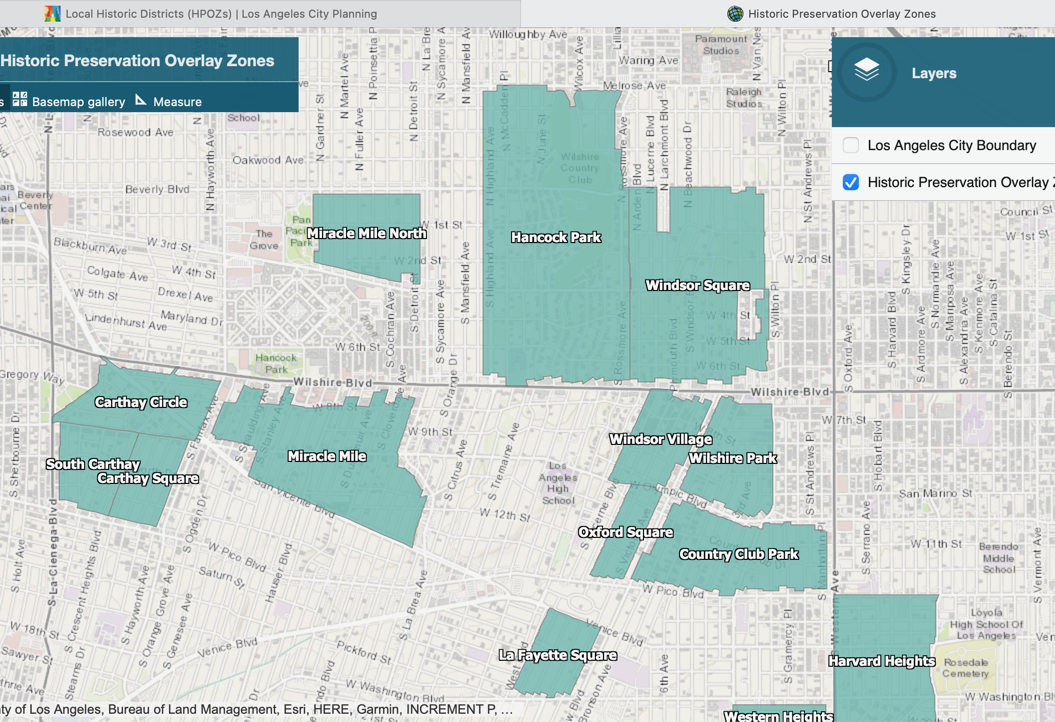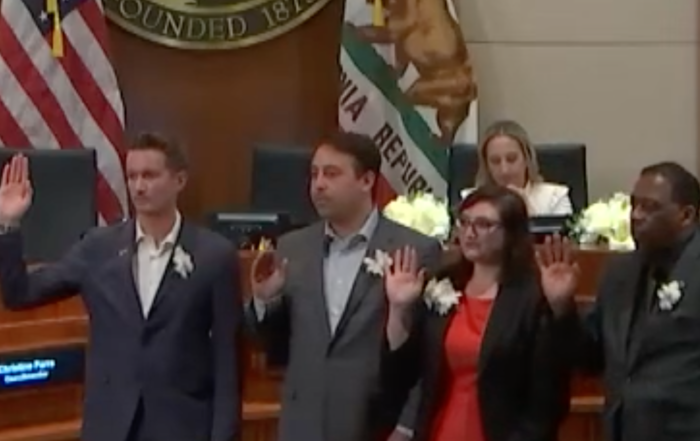When the Miracle Mile Democratic Club and the Mid City West Neighborhood Council convened to discuss proposed restrictions that would protect historic neighborhoods from the swift development of affordable housing, they noticed something peculiar.
The Historic Preservation Overlay Zones (HPOZ) for wealthy neighborhoods like Hancock Park, Carthay Circle, and Windsor Square roughly corresponded to old realtor redlining maps from the late 1930s, which sought to exclude minorities.
In a letter to Councilmember Katy Yaroslavsky, which opposed her motion to reimpose HPOZ review on affordable housing projects, the Mid City West Neighborhood Council wrote, “The historical legacies of these neighborhoods is not simply their architecture — these were the neighborhoods that actively excluded and segregated against Jews, African Americans, and other minorities until only a few decades ago. Single-family zoning and historical overlays were used extensively in Los Angeles to maintain exclusionary patterns after redlining became illegal. By disallowing ED1 projects even where these neighborhoods allow multi-family housing, your motion would reestablish and entrench that exclusionary legacy.”
Despite this opposition, Mayor Karen Bass on July 1 established new guidelines and restrictions for Executive Directive 1 (ED1), a directive which seeks to remedy the homelessness crisis by expediting the development of shelters and affordable housing. The new guidelines do not allow developers to apply for ED1 fast-tracking of affordable housing in HPOZ areas, fire danger zones, or where rent-stabilized units exist.
As for the juxtaposition of old and new maps—not so fast, says Aaron Barrall, Housing Data Analyst at UCLA’s Lewis Center for Regional Policy.
“There are lots of neighborhoods in South Los Angeles and lower-income communities within the city that also have HPOZs applied to them,” he said. “When I did a rough analysis of the neighborhoods, it wasn’t super skewed in one direction, either towards lower income neighborhoods or higher income.”
And neighborhoods like Hancock Park, Carthay Circle, and Windsor Square are no longer segregated or racially homogeneous, noted Maria Pavlou Kalban, founder of United Neighbors, which advocates for local preservation and slower development.
“But if you build something huge and out of scale in these historic districts, it matters,” she said. “If you go down any large street, a commercial street in L.A., like Pico or Sepulveda Boulevard, a lot of it is low density, one story, large parking lots, very underutilized. That’s where we say we need to incentivize developers to build because then you can create new communities, new developments that will provide not only affordable housing but mixed-income housing that we also need.”
On the other hand, creating affordable housing solely along commercial corridors gives rise to substantial equity concerns, said Barrall.
“Only building on corridors is not fair or equitable, either,” he said. “Why should people who live in apartments be subjected to more noise and more air pollution than somebody who lives essentially right next to the corridor, but maybe half a block off or a few properties off the corridor?”
“It makes sense to have some reasonable guidelines on projects in historic districts,” he continued, “but by completely taking those off of the table for the streamlining through ED1, the city is losing out on some good opportunities, especially along the Wilshire Corridor area where we’re investing billions of dollars in a new rail system.”
Lauren Borchard, First Vice Chair of the Mid City West Neighborhood Council, looks forward to the 2025 opening of new stops along the purple Metro line, which will run from Union Station through the Miracle Mile and into Westwood.
“In terms of where there should be the highest priority [for development], it’s the areas around these new transit stops on the Purple Line,” she said, noting that several of these stops are adjacent to HPOZ neighborhoods. “I think that anybody who cares about environmentalism, transportation, or housing realizes that they’re all inherently intersectional. You can’t advocate for one without the other.”
Kalban worries about the encroachment of tall, boxy apartment complexes adjacent to HPOZs along the Wilshire corridor. She encourages architectural aesthetics to be taken into consideration, advocating for setbacks from the street as well as stepbacks that create recessed levels on roofs, allowing for more light and space for surrounding properties, not just giant buildings that overshadow single-family homes and unique neighborhoods.
“When we talk about building on the corridors, we’re hoping that there’s a design element to it so that you do have courtyards, and you do have open spaces,” she said. “It’s not just a square box, and a lot of what’s getting built are just that. And I think that’s a pity when you have a city that first of all is concerned about climate change, and they don’t worry about the loss of all this open space, but it has a climate that should encourage people to enjoy the outdoors. So you know, sometimes you panic that you don’t have enough housing, and at the same time, you should be encouraging good housing to be built here.”
Despite the advocacy for gentle density and architecture that blends into a neighborhood’s aesthetics, time is of the essence during a homelessness crisis of epic proportions, according to Borchard.
“Of course, I appreciate good design,” said Borchard, “but we need more units, and we need them faster. … These delays prevent projects. Developers won’t even propose if it could take four or five years to get through the process.”
Yet the streamlined approval process under ED1 has already demonstrated drawbacks, particularly for those who live at 4319 Toland Way in Eagle Rock, who may be evicted from their rent-controlled apartments, which are potentially slated to be demolished in favor of affordable housing.
Though Mayor Bass’s office did not respond to clarifying questions, Leo Daube, the Communications Director for Councilmember Yaroslavsky, said that the updated ED1 guidelines seek to resolve such contentious quandaries around the Rent Stabilization Ordinance (RSO) and HPOZ areas.
“If a 100 percent, affordable housing developer wants to come in and develop housing [in an HPOZ or RSO area], that’s great, but they should go through the normal processes,” he said. “They need to go through the standard planning process that exists outside of ED1.”
Image of Historic Preservation Overlay Zones taken via screen capture.
Stay informed. Sign up for The Westside Voice Newsletter
By clicking submit, you agree to share your email address with Westside Voice. We do not sell or share your information with anyone.








